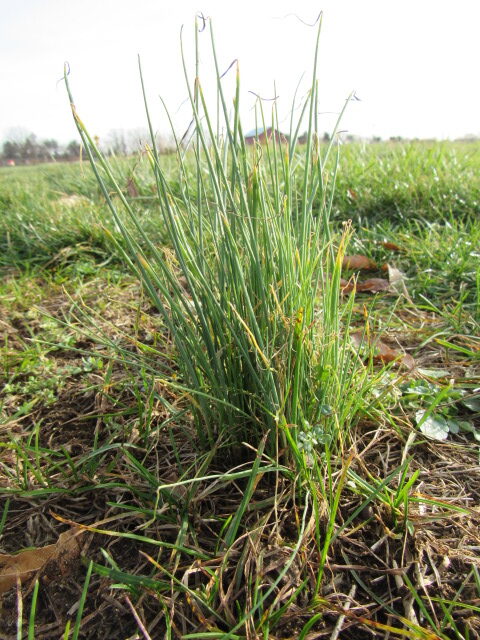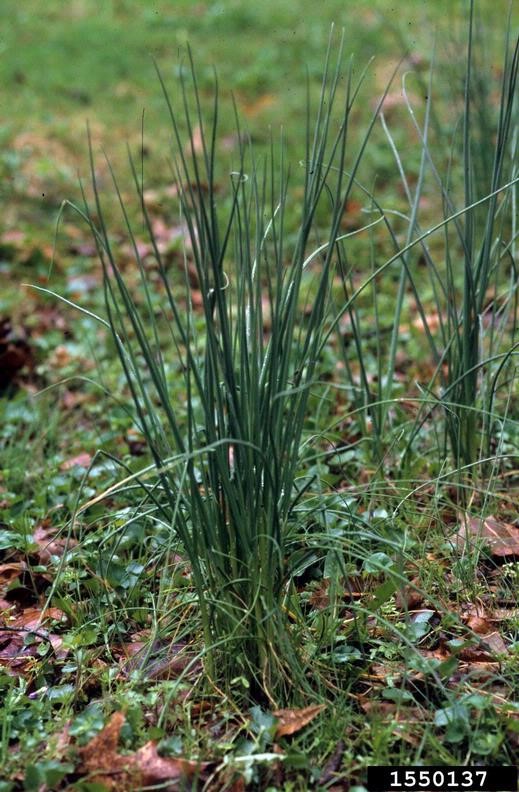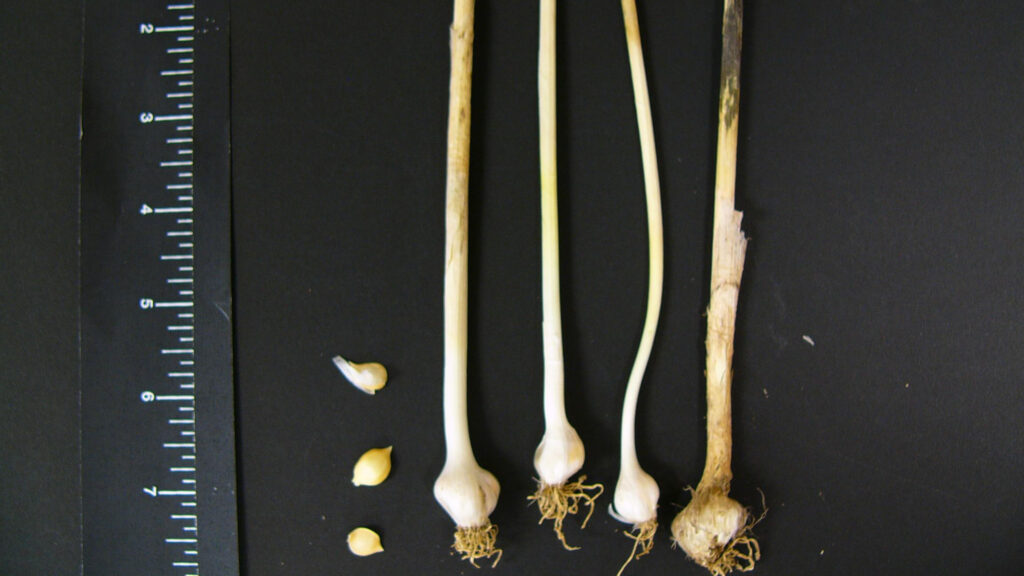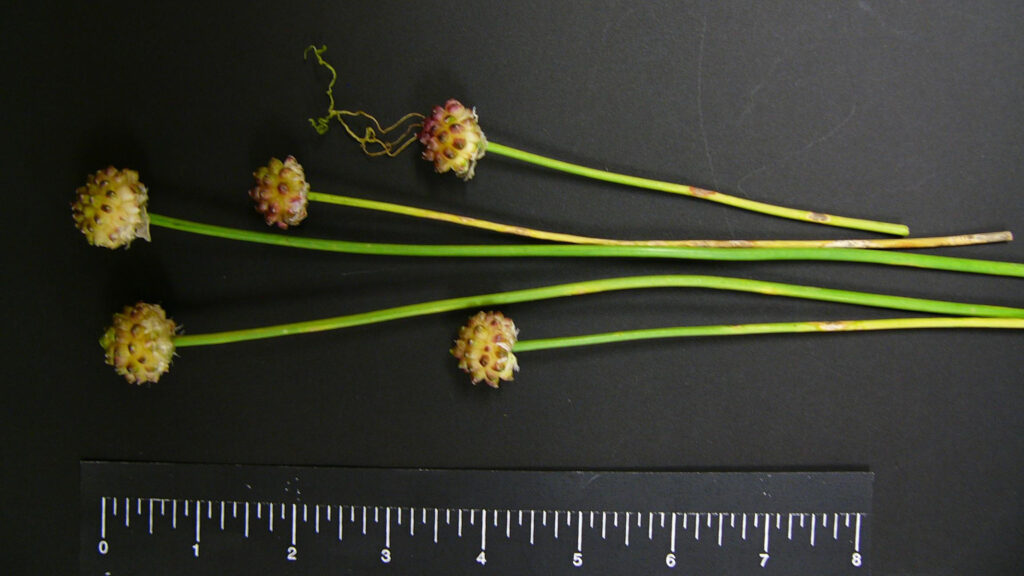Main Content

Written by Joanna Guldin, Rowan College of South Jersey, Gloucester County Intern Scholarship Program
Wild Garlic (Allium vineale L.) is a bulbous perennial weed often found in turfgrass and landscape beds. It is present during the fall and spring and can be easily identified by the strong odor of crushed leaves.
Importance as an Agricultural Weed
Wild garlic emerges in late fall from underground bulbs and grows through the winter and spring. The plant forms aerial bulblets in the late spring, and the plants die back in the early summer. This weed can be challenging to manage because its underground bulbs can persist in the soil for several years.
This weed rarely causes noticeable yield loss, but infestations can be troublesome in agricultural fields. Wild garlic is known to reduce the value of farm produce, slow the harvest of vegetable crops, and produce an unpleasant taste in milk and meat. Farm produce is largely impacted because wild garlic is known to taint the crops. Vegetable crops are less impacted by wild garlic, but separating the thin leaves from salad and braising greens can slow harvest of these crops. Wild garlic is known to produce an unpleasant taste in milk and meat when it is consumed by pastured livestock.
Wild garlic can also be troublesome in the harvest of cereal grains. The bulblets of wild garlic are harvested with the grains and are difficult to clean out of the grain. This contamination causes the grain to have an unpleasant taste and odor. Mills often reject contaminated grain shipments because the bulblets inside the grain can also cause caking on the mill, which would necessitate frequent cleaning.
Key Characteristics for Identification
| Characteristics | Description |
| Overall Appearance | Flowers and dormant bulbs on the flowering stem Bulbs are egg-shaped with papery coverings Fibrous root system Unbranched, round, smooth, leafless, and solid cored stalks |
| Leaf Attributes | 6-24 inches tall by 0.1-0.4-inch wide Smooth, round, hollow leaves Emit strong garlic odor when crushed |
| Bulblets | Small and teardrop shaped Thin, green leaf emerging from the top |
| Presence of Hairs | Seedlings are hairless |
| Flowers | Maroon, pink, or white-green flowers may develop Three-chambered, egg-shaped capsules Capsules contain up to 6 flat, wrinkled, black seeds |
Wild onion can be mistaken for wild garlic because they both have thin, green, waxy leaves. The main difference is that wild garlic has round and hollow leaves, whereas wild onion has flat and solid leaves.
Chemical Control Options
For herbicide recommendations, refer to the following publications. Additional commercial crop production guides can be found here. Contact your local county Extension office with specific questions.
- Field Crops: Mid-Atlantic Field Crop Weed Management Guide
- Vegetable Crops: Mid-Atlantic Commercial Vegetable Production Recommendations
- Turfgrass: NJAES Factsheet 385 Broadleaf Weed Control in Cool Season Turfgrasses
- Home Landscape: NJAES Bulletin 272 Weed Management in Ornamental Plantings
Integrated Weed Management Strategies
Wild garlic can be easily killed with tillage in the late fall to early spring. During this time, two foliage leaves of wild garlic should be well formed. Tillage at this time destroys growing plants, but keep in mind that development is not synchronized across all plants. With that being said, several years of appropriately timed tillage would be necessary to keep the infestation under control.
Land rotations to spring planted row crops are beneficial in controlling wild garlic infestations. They allow for spring tillage and repeated cultivation, which would damage the plants during the formation of offset bulbs and bulblet bearing stalks.
Wild garlic is not a competitive weed. Competition from a dense stand of perennial grasses or legumes can easily suppress wild garlic for several years. Therefore, to control light infestation in your pasture, ensure a vigorous growth of grasses and legumes between grazing episodes. This will decrease the percentage of wild garlic in the forage and reduce the risk of tainting milk and meat.
Avoid early grazing of infested fields to reduce the potential for tainting of animal products. Also avoid planting winter grains, as the bulblet bearing stalks can contaminate the harvested grain. Winter grain can be successfully grown if the crop is vigorous and fertilized well. If the stand is not successful, consider harvesting the crop for hay.



References
Abbey, T. (2015, May 7). Wild Onion and Wild Garlic. PennState University. https://extension.psu.edu/wild-onion-and-wild-garlic
Daughtry, M. (2020, December 17). Wild Onion & Wild Garlic: Kill, Control & Prevent It. NC Cooperative Extension. https://lee.ces.ncsu.edu/2015/02/wild-onionwild-garlic-kill-control-prevent-it-2/
Mohler, C.L., Teasdale, J.R., & DiTommaso, A. (2021). Major agricultural weeds of the United States and Canada. In L. Barba (Ed.), Manage weeds on your farm: A guide to ecological strategies. Sustainable Agriculture Research and Education.
Uva, R.H., Neal, J.C., & DiTomaso, J.M. (1997). Weeds of the Northeast. Cornell University Press.